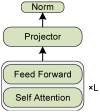Fine-Grained Cross-Modal Semantic Consistency in Natural Conservation Image Data from a Multi-Task Perspective
- PMID: 38793984
- PMCID: PMC11125332
- DOI: 10.3390/s24103130
Fine-Grained Cross-Modal Semantic Consistency in Natural Conservation Image Data from a Multi-Task Perspective
Abstract
Fine-grained representation is fundamental to species classification based on deep learning, and in this context, cross-modal contrastive learning is an effective method. The diversity of species coupled with the inherent contextual ambiguity of natural language poses a primary challenge in the cross-modal representation alignment of conservation area image data. Integrating cross-modal retrieval tasks with generation tasks contributes to cross-modal representation alignment based on contextual understanding. However, during the contrastive learning process, apart from learning the differences in the data itself, a pair of encoders inevitably learns the differences caused by encoder fluctuations. The latter leads to convergence shortcuts, resulting in poor representation quality and an inaccurate reflection of the similarity relationships between samples in the original dataset within the shared space of features. To achieve fine-grained cross-modal representation alignment, we first propose a residual attention network to enhance consistency during momentum updates in cross-modal encoders. Building upon this, we propose momentum encoding from a multi-task perspective as a bridge for cross-modal information, effectively improving cross-modal mutual information, representation quality, and optimizing the distribution of feature points within the cross-modal shared semantic space. By acquiring momentum encoding queues for cross-modal semantic understanding through multi-tasking, we align ambiguous natural language representations around the invariant image features of factual information, alleviating contextual ambiguity and enhancing model robustness. Experimental validation shows that our proposed multi-task perspective of cross-modal momentum encoders outperforms similar models on standardized image classification tasks and image-text cross-modal retrieval tasks on public datasets by up to 8% on the leaderboard, demonstrating the effectiveness of the proposed method. Qualitative experiments on our self-built conservation area image-text paired dataset show that our proposed method accurately performs cross-modal retrieval and generation tasks among 8142 species, proving its effectiveness on fine-grained cross-modal image-text conservation area image datasets.
Keywords: cross-modal; cross-modal alignment; cross-modal retrieval; image captioning; multi-task.
Conflict of interest statement
The authors declare that the research was conducted in the absence of any commercial or financial relationships that could be construed as potential conflicts of interest.
Figures









Similar articles
-
Histopathology language-image representation learning for fine-grained digital pathology cross-modal retrieval.Med Image Anal. 2024 Jul;95:103163. doi: 10.1016/j.media.2024.103163. Epub 2024 Apr 9. Med Image Anal. 2024. PMID: 38626665
-
Latent Space Semantic Supervision Based on Knowledge Distillation for Cross-Modal Retrieval.IEEE Trans Image Process. 2022;31:7154-7164. doi: 10.1109/TIP.2022.3220051. Epub 2022 Nov 16. IEEE Trans Image Process. 2022. PMID: 36355734
-
Disambiguity and Alignment: An Effective Multi-Modal Alignment Method for Cross-Modal Recipe Retrieval.Foods. 2024 May 23;13(11):1628. doi: 10.3390/foods13111628. Foods. 2024. PMID: 38890857 Free PMC article.
-
A Fine-Grained Semantic Alignment Method Specific to Aggregate Multi-Scale Information for Cross-Modal Remote Sensing Image Retrieval.Sensors (Basel). 2023 Oct 13;23(20):8437. doi: 10.3390/s23208437. Sensors (Basel). 2023. PMID: 37896530 Free PMC article.
-
From Show to Tell: A Survey on Deep Learning-Based Image Captioning.IEEE Trans Pattern Anal Mach Intell. 2023 Jan;45(1):539-559. doi: 10.1109/TPAMI.2022.3148210. Epub 2022 Dec 5. IEEE Trans Pattern Anal Mach Intell. 2023. PMID: 35130142 Review.
Cited by
-
An Audiovisual Correlation Matching Method Based on Fine-Grained Emotion and Feature Fusion.Sensors (Basel). 2024 Aug 31;24(17):5681. doi: 10.3390/s24175681. Sensors (Basel). 2024. PMID: 39275592 Free PMC article.
References
-
- Matin M., Shrestha T., Chitale V., Thomas S. Exploring the potential of deep learning for classifying camera trap data of wildlife: A case study from Nepal; Proceedings of the AGU Fall Meeting Abstracts; New Orleans, LA, USA. 13–17 December 2021; p. GC45I-0923.
-
- Zett T., Stratford K.J., Weise F. Inter-observer variance and agreement of wildlife information extracted from camera trap images. Biodivers. Conserv. 2022;31:3019–3037. doi: 10.1007/s10531-022-02472-z. - DOI
-
- McShea W.J., Forrester T., Costello R., He Z., Kays R. Volunteer-run cameras as distributed sensors for macrosystem mammal research. Landsc. Ecol. 2016;31:55–66. doi: 10.1007/s10980-015-0262-9. - DOI
LinkOut - more resources
Full Text Sources

